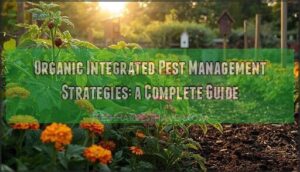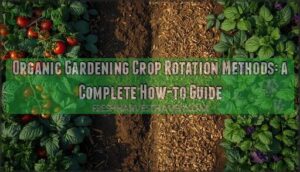This site is supported by our readers. We may earn a commission, at no cost to you, if you purchase through links.
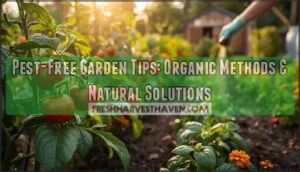
The good news is you don’t need toxic chemicals to protect your plants. A few smart prevention strategies and natural remedies can keep your garden thriving without poisoning the soil or harming beneficial insects.
The secret lies in understanding how pests think and creating an environment where your plants have the upper hand.
Table Of Contents
- Key Takeaways
- Essential Tips for a Pest-Free Garden
- Organic Methods to Prevent Pest Problems
- Natural Solutions for Treating Garden Pests
- Promoting a Healthy, Balanced Garden Ecosystem
- Top 5 Products for Organic Pest Control
- Frequently Asked Questions (FAQs)
- How can I prevent pests in my garden?
- How do plants keep pests away?
- What is the best form of pest control?
- What is the organic pest control method?
- Are pests in the garden a problem?
- Is pesticide-free gardening a good idea?
- How often should I inspect plants for pests?
- What time of day is best for treatments?
- Can household items replace commercial pest controls?
- Which seasons have the highest pest activity?
- Conclusion
Key Takeaways
- A pest-resistant garden starts with prevention through physical barriers like mesh and row covers, companion planting with pest-repelling species like marigolds and alliums, and maintaining healthy soil that helps plants naturally defend themselves against damage.
- Daily inspections catch infestations early when they’re easiest to control, allowing you to spot warning signs like holes, sticky residue, or visible pests before minor problems become garden-wide disasters.
- Natural remedies like castile soap sprays, hand-picking, and attracting beneficial insects (ladybugs, lacewings, parasitic wasps) provide effective pest control without toxic chemicals that harm pollinators and disrupt your garden’s ecosystem.
- Strong plant health through proper soil nutrition, composting, crop rotation, and balanced watering creates resilient crops that resist pest damage better than any spray—making prevention your most powerful tool.
Essential Tips for a Pest-Free Garden
If you want a garden that actually produces food instead of feeding the neighborhood bugs, you need a game plan. Pests show up when plants are thriving, so your job is to stay one step ahead.
Here are the essential strategies that keep your garden healthy and productive without reaching for harsh chemicals.
Recognizing Common Garden Pests
Spotting garden pests early gives you the upper hand. Learn to identify the usual suspects before they throw a party in your plants.
- Aphids cluster on new growth and undersides of leaves, leaving sticky honeydew that attracts ants
- Slugs and snails leave silvery slime trails and ragged holes in leafy greens overnight
- Beetles like Japanese varieties skeletonize leaves, leaving lacy patterns on over 300 plant species
- Caterpillars chomp large sections of foliage and leave dark droppings near damaged areas
To prevent infestations, early intervention is key.
Preventing Pest Entry With Barriers
Once you know what you’re dealing with, your next move is building a fortress they can’t breach. Physical barriers like garden mesh and row covers work like invisible shields when installed right. Cover transplants from day one and secure edges with stakes or soil.
Fine insect mesh blocks aphids and flea beetles, while heavier materials protect against birds. Fruit protection bags guard individual harvests. Barrier height matters for climbing pests, and seasonal adjustments keep defenses tight year-round.
Early Signs of Pest Infestation
Even the best barriers won’t help if you miss the warning signs that pests have already moved in. Check for leaf damage like holes or chewed edges. Stunted growth and unusual markings signal trouble. Spot visible pests on stems or undersides of leaves. Sticky honeydew presence means aphids are nearby.
Monitoring plant health daily catches early signs of pest infestation before serious pest damage takes hold.
Maintaining Plant Health for Defense
The best defense against pests isn’t a spray bottle—it’s a plant that’s healthy enough to fight back on its own. Strong plants resist damage better and recover faster. Focus on soil health with good compost and proper watering practices. Give plants adequate sunlight exposure and maintain nutrient balance through regular feeding.
- Test your soil to identify deficiencies before adding amendments
- Water deeply but less frequently to encourage strong root systems
- Prune damaged leaves promptly to redirect energy toward healthy growth
Avoiding Harmful Chemical Pesticides
Chemical pesticides might promise a quick fix, but they’re like calling in a demolition crew when you need a handyman—they’ll wipe out the good guys along with the bad. Beneficial insects like ladybugs and bees become collateral damage.
Chemical pesticides wipe out beneficial insects like ladybugs and bees along with the pests you’re trying to eliminate
Instead, embrace organic pest control methods and integrated pest management. Natural defenses strengthen healthy ecosystems while protecting pollinators. These pesticide alternatives support organic gardening without compromising your garden’s balance.
Organic Methods to Prevent Pest Problems
The best defense against pests starts before they even show up. By building smart habits into your gardening routine, you can stop most problems before they start.
Here are five organic methods that create a naturally pest-resistant garden.
Physical Barriers Like Garden Mesh
If you want pests to stay out of your garden, sometimes the simplest solution is to just lock the door. Garden mesh and physical barriers give you real crop protection without chemicals.
Install fine mesh at planting time for leafy greens and root crops. It blocks aphids and flea beetles while protecting plants from pests and harsh weather. Check your barriers weekly for tears to keep pest prevention working.
Companion Planting Strategies
Pairing plants strategically creates a pest-fighting shield without sprays. Marigolds cut nematode damage by 90% and slash aphid numbers by 80% when grown near vegetables. Alliums reduce aphid impacts by 61%, while basil decreases hornworm attacks on tomatoes by 46%.
These companion planting techniques attract beneficial insects, boost soil health, and improve yields—sometimes by 32% or more. Mix strong-scented herbs like mint with your crops to naturally mask plant scents and lower pest colonization rates.
Polyculture gardens can experience a significant yield increase, as demonstrated by strawberry crops.
Crop Rotation and Plant Selection
Moving crops to fresh ground each season breaks pest cycles that would otherwise camp out and multiply in your soil. Rotation benefits extend beyond pest and disease prevention—you’re also rebuilding soil health naturally.
Switch up crop families each year so cabbage worms can’t feast on brassicas in the same spot. Choose pest-resistant varieties when selecting plants.
This sustainable gardening approach starves out soil pests and strengthens your organic gardening defense system.
Proper Composting and Mulching
Good compost feeds your plants, while bad compost invites trouble—and the difference starts with what you throw in the pile. Skip pesticide-treated grass clippings and diseased plant matter that carry pests forward. Quality compost enriches soil nutrients and fuels healthy growth.
Layer these organic matter sources for best results:
- Brown materials like dry leaves and straw for carbon
- Green materials including vegetable scraps for nitrogen
- Finished compost to kickstart nutrient cycling
- Mulch on top for moisture retention and weed suppression
Your soil will thank you.
Regular Weeding and Debris Removal
Weeds steal water and nutrients while offering pests a cozy hideout right next to your prized tomatoes. Pull them early and often—weed identification helps you catch invaders before they spread. Clear fallen leaves and plant debris since pests love hiding in the mess.
Keep your tools sharp for cleaner cuts and apply mulch after weeding to block new growth. This natural pest control routine aids your organic gardening goals while starving bugs of shelter.
Natural Solutions for Treating Garden Pests
When pests show up despite your best prevention efforts, you need a plan to tackle them without reaching for harsh chemicals. The good news is that nature provides plenty of effective solutions that work with your garden instead of against it.
Here are five gentle but powerful methods to treat pest problems organically.
Pruning Affected Plant Areas
When you spot pest damage on a plant, your first line of defense is a clean pair of pruning shears. Identifying damage early matters because it stops plant diseases from spreading.
Cut below the affected area and dispose of infected leaves in sealed bags—not your compost pile. This prevents spread to healthy plants. Handpick pests you see while pruning.
Proper cuts support plant health and help your garden bounce back faster.
Homemade Organic Sprays and Soaps
After pruning, you can make your own organic bug sprays for extra protection. These homemade insecticide solutions target soft-bodied pests without harming beneficial insects when applied carefully.
Four effective recipes:
- Insecticidal soap – Mix 5 tablespoons castile soap per gallon of water for aphids and mites
- Garlic spray – Blend garlic cloves with water; strain and spray to repel beetles
- Essential oils – Combine peppermint or clove oil with water for broad pest control
- Hot pepper mix – Steep cayenne in water to deter caterpillars
Application timing matters. Spray early morning or evening to avoid soap toxicity from sun exposure. Reapply after rain. Cost savings add up since ingredients cost under $1 per gallon versus $10-plus commercial options. Environmental impact stays low with proper targeting.
Attracting and Releasing Beneficial Insects
Your best allies in the fight against pests are other bugs—the ones that eat the troublemakers for breakfast. Attracting beneficial insects like ladybugs, lacewings, and parasitic wasps transforms your garden into a self-regulating ecosystem.
Plant flowers like yarrow and dill to invite these predator insects naturally. You can also purchase ladybugs or release predatory nematodes into the soil.
Creating ladybug habitats with mulch and shelter encourages them to stick around while providing mantis benefits through season-long pest control.
Hand-Picking and Monitoring Pests
Sometimes the best pest control tool isn’t a spray or a trap—it’s your own two hands and a few minutes of attention each day. Hand picking pests works wonders for larger culprits like tomato hornworms and beetles.
Check your garden every morning for damage assessment and pest identification. Monitoring frequency matters—daily inspections catch problems before they explode.
Tool selection is simple: gloves and a bucket of soapy water get the job done using natural pest control that’s totally free.
Managing Soil Pests and Slugs
Beneath the surface, in the dark world of your soil, a whole different gang of pests is quietly munching away at roots and tender seedlings. Managing soil pests means dealing with slugs and snails that appear after rain. Beer traps work great for slug control.
Beneficial nematodes hunt down soil pests naturally. Soil solarization kills nematode populations using the sun’s heat. Check beneath mulch where these critters hide during daylight.
Promoting a Healthy, Balanced Garden Ecosystem
A pest-free garden isn’t just about keeping bugs away. It’s about building a garden that can withstand a few nibbles without falling apart.
Here’s how to create an environment where your plants thrive and pests don’t take over.
Encouraging Pollinators and Predators
Think of your garden as a neighborhood where the good guys keep the bad guys in check. Floral diversity is your secret weapon here. About 35% of food crops depend on pollinators, and these busy workers double as your pest control allies.
Plant native flowers to attract beneficials like ladybugs and lacewings that devour aphids. Habitat connectivity matters too—corridors of blooms help predators patrol up to 150 feet into your garden.
Skip the pesticides, though, since they hammer wild bee populations and disrupt the natural balance you’re building.
Creating Bird- and Insect-Friendly Habitats
Birds and insects need more than just flowers—they need year-round shelter, water sources, and safe spots to raise their young. Set up bird houses and insect hotels near native plants to create a thriving wildlife garden. Add shallow dishes of water for drinking and nesting materials like twigs.
These habitats naturally attract predators that feast on aphids and caterpillars, inviting beneficial insects to patrol your garden while birds pick off larger pests.
Avoiding Overuse of Any Pesticide
Even organic pesticides can backfire if you spray them like there’s no tomorrow—too much of a good thing disrupts the very ecosystem you’re trying to protect. Integrated pest management strategies rely on pest thresholds and targeted treatments rather than blanket applications.
This preserves beneficial insects and maintains natural balance. An integrated approach recognizes that systemic effects from overuse can harm pollinators and predators you’ve worked hard to attract, undermining your organic gardening efforts entirely.
Regular Garden Observation and Care
Spotting trouble early beats scrambling to save a wilting plant—a quick daily walk through your garden beds gives you eyes on every leaf, stem, and soil patch before small issues snowball. Daily pest checks during watering practices let you monitor soil health and plant nutrition in one sweep.
Timely intervention means pinching off that first aphid cluster or adjusting mulch depth before you’re fighting a full-blown infestation. Garden maintenance isn’t a chore when it’s just five minutes of garden planning that keeps you ahead of the game.
Supporting Plant Resilience Naturally
Strong plants don’t just survive pests—they shrug them off like water off a duck’s back, and that kind of toughness starts with what you feed the soil. Promoting plant health through balanced soil nutrients gives your crops natural defenses they can actually use.
Here’s how to build that resilience:
- Boost soil quality with organic fertilizers and compost free of contaminants
- Diversify your plantings so soil health improves through varied root systems
- Fine-tune sunlight and water management to prevent stress-weakened plants
- Balance soil nutrients without overfeeding—strong doesn’t mean overfed
Plant nutrition drives everything else in your garden ecosystem.
Top 5 Products for Organic Pest Control
Sometimes you need to bring in reinforcements to keep pests at bay. The right products can make organic pest control easier and more effective.
Here are five tried-and-true options that work with nature instead of against it.
1. Dr Bronner’s Baby Unscented Castile Soap
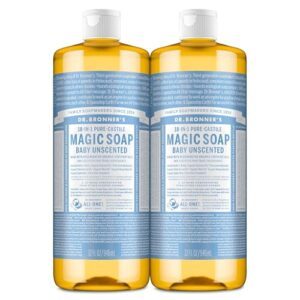
When soft-bodied pests invade your garden, Castile soap delivers effective pest disruption without harsh chemicals. Dr. Bronner’s Baby Unscented formula works as an insecticidal soap by breaking down the protective coating on aphids, spider mites, and whiteflies.
Soap dilution is simple: mix one tablespoon per quart of water for a homemade remedy that’s safe for edible plants. Spray both leaf surfaces early morning or evening, repeating every four to seven days.
This organic bug spray option aids natural pest control while minimizing environmental impact. Safe application requires spot testing first and rinsing produce before eating.
Best For: Gardeners seeking a biodegradable, non-toxic pest control solution for soft-bodied insects on edible plants and sensitive garden areas.
- Effectively disrupts aphids, spider mites, whiteflies, and mealybugs on contact without synthetic chemicals or toxic residues
- Safe for children, pets, and pollinators when used as directed, with biodegradable ingredients that minimize environmental impact
- Highly concentrated formula (3x more than typical liquid soaps) provides cost-effective pest management with simple 1 tablespoon per quart dilution
- Requires repeated application every 4-7 days and only works on direct contact, making it less effective for severe or widespread infestations
- May cause leaf spotting or burns on sensitive plants if over-applied or improperly diluted, requiring spot testing before full use
- Limited effectiveness against hard-bodied insects, eggs, and pests not directly sprayed, necessitating daily treatment for heavy infestations
2. Garden Netting Pest Barrier Screen
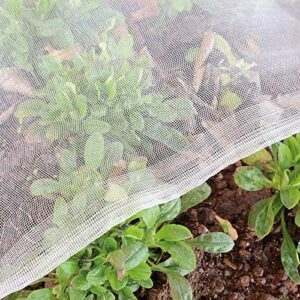
For year-round pest control, garden mesh delivers physical barriers that stop insects before they reach your vegetables. Made from high-density polyethylene (HDPE), this UV-resistant netting material types include options ranging from lightweight 40-mesh screens to fine insect barriers that block even tiny aphids and flea beetles.
Mesh size matters more than you’d think. Fine weaves with openings around 0.27 mm exclude whiteflies and thrips with nearly 100% efficiency when properly matched to pest dimensions. While tighter weaves reduce airflow impact by 16% to 35%, they still allow essential light, water, and air through for healthy plant growth.
Installation techniques are straightforward: drape mesh over garden hoops or secure edges by burying, weighing down, or using fabric staples. This creates an impenetrable zone for your vegetable garden without chemicals. Economic viability improves with proper care—quality netting lasts over seven years when cleaned regularly and stored dry between seasons, making it a smart investment in organic pest control methods.
Best For: Home gardeners and organic growers who want chemical-free pest protection for vegetables and fruits without compromising plant health.
- Blocks 99% of target insects including aphids, whiteflies, and thrips while allowing air, water, and light through for healthy plant growth
- Lasts over 7 years with proper maintenance, making it a cost-effective long-term investment in pest control
- UV-resistant HDPE material can be cut to any size and works in multiple settings from open gardens to greenhouses
- Edges aren’t sewn, so friction from rubbing on hoops can cause tearing or unraveling over time
- Reduces airflow by 16% to 35% depending on mesh tightness, which may affect ventilation in enclosed spaces
- Can feel rigid and requires additional support structures like hoops or frames for effective installation
3. Fruit Protection Bags with Drawstring
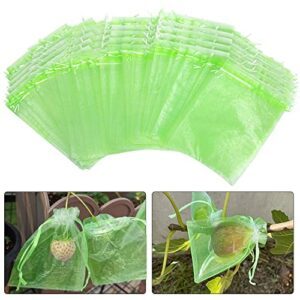
While mesh covers rows of plants, fruit protection bags with drawstring closures let you shield individual fruits from pests with surgical precision. These organza bags create physical barriers around apples, peaches, berries, and other high-value crops. The bagging technique is simple: slip the bag over developing fruit and cinch the drawstring tight around the stem.
Studies show this approach slashes insect damage by up to 91% and cuts bird losses by 85%. Beyond pest control, the bag material blocks fungal diseases like sooty blotch by 60-78%.
At just $0.02 to $0.08 per bag, this cost analysis favors growers seeking organic pest control methods without spraying.
Best For: Home gardeners and commercial growers who want to protect individual fruits from pests and diseases without using chemical pesticides.
- Cuts insect damage by up to 91% and bird losses by 85%, while reducing fungal diseases by 60-78% through a simple physical barrier around each fruit.
- Extremely affordable at $0.02 to $0.08 per bag, with durable organza bags lasting up to three growing seasons and reducing pesticide costs by 30-40%.
- Easy to use with drawstring closures that secure tightly around stems, allowing sunlight and air circulation while blocking pests from apples, berries, peaches, and other crops.
- Some bags arrive with broken or poorly sewn drawstrings that can fail to keep pests out if not tied securely.
- Requires manual installation and removal for each individual fruit, which can be time-consuming for large orchards or gardens.
- May not stop determined small animals like squirrels, and incorrect sizing or loose drawstrings can allow tiny insects to slip through.
4. Bonide All Season Spray Oil
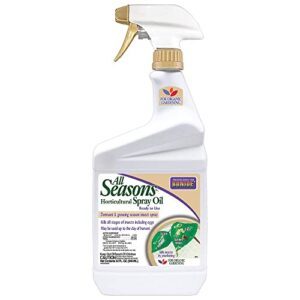
When bags won’t work for entire plants, Bonide All Season Spray Oil steps in with refined mineral oil that smothers aphids, spider mites, and scale on contact. This organic approval product also controls powdery mildew and leaf spot.
Mix it with water and spray during the growing season, adjusting oil concentration based on plant sensitivity—cucumbers and tomatoes require caution. Application methods are straightforward, though multiple treatments may be needed for stubborn infestations.
At about $15 for concentrate, its cost effectiveness surpasses many organic bug sprays. Unlike Neem oil, it works year-round as part of your natural pest control arsenal.
Best For: Gardeners seeking an affordable, organic-approved solution for year-round pest and disease control on vegetables, fruit trees, and ornamentals without harsh chemicals.
- Effective broad-spectrum control against aphids, spider mites, scale, powdery mildew, and leaf spot through contact smothering action
- Approved for organic gardening and safe to use throughout the growing season on most plants
- Cost-effective concentrate at around $15, providing better value than premixed organic sprays or neem oil alternatives
- Requires careful application on sensitive plants like cucumbers and tomatoes to avoid foliage damage
- May need multiple treatments for heavy infestations or stubborn pest problems
- Some users report inconsistent product formula or quality between batches
5. Quictent Mini Cloche Greenhouse Elevated
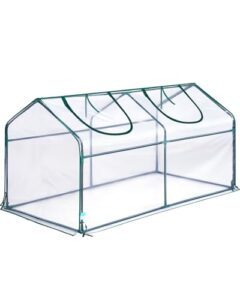
To lock out flying and crawling pests before they arrive, the Quictent Mini Cloche Greenhouse Elevated creates a sealed microclimate improvement zone over your vegetable garden. Its powder-coated steel frame and waterproof PVC cover act as a cloche pest barrier that works like row covers and garden mesh combined.
Users report structural durability through high winds and seasons of use, with organic yields rising as pest pressure drops. At 71×36×36 inches, it shields tender greens and young transplants while improving germination rates—user longevity reviews confirm it’s worth the investment for serious pest control.
Best For: Organic gardeners who want a durable, pesticide-free solution to protect tender plants from flying and crawling pests while extending the growing season.
- Creates a fully sealed barrier that keeps out aphids, whiteflies, caterpillars, and larger foraging animals without chemicals—users report significantly fewer pest problems across all four seasons.
- Maintains a warmer microclimate that boosts germination rates up to 95% and extends both spring and fall growing windows, with the waterproof PVC cover holding up through wind and weather.
- Easy setup with a powder-coated steel frame that stays stable in winds up to 30 mph when anchored, plus roll-up zippered doors for quick access and ventilation control.
- Lightweight construction may require extra weighting or rebar anchoring in high-wind areas to prevent shifting or tipping.
- Zipper doors can be delicate and need careful handling to avoid snags from soil or plant debris that could compromise the seal.
- PVC cover may develop tears or damage over time with rough handling, though most users report 12–18 months of solid performance before any wear shows.
Frequently Asked Questions (FAQs)
How can I prevent pests in my garden?
The best defense is a good offense. Start with implementing physical barriers like garden mesh right at planting time. Choose pest-resistant plant varieties and maintain excellent soil health through proper composting.
Keep your garden tidy by removing debris where pests hide, and check plants daily for early detection of trouble.
How do plants keep pests away?
Certain clever companions create chemical compounds that confuse and repel pests naturally. Plant defenses include allelopathy, where roots release substances that deter insects.
Natural repellents from herbs and alliums work alongside beneficial microbes in healthy soil to boost pest resistance and strengthen your garden ecosystem.
What is the best form of pest control?
An integrated approach works best. This combines prevention with natural predators, beneficial insects, and plant resilience.
Focus on ecosystem balance through organic gardening methods rather than reactive treatments. Healthy soil and diverse plantings create natural pest control systems.
What is the organic pest control method?
Organic pest control methods rely on physical barriers, companion plants, and natural predators like ladybugs to manage pests without chemicals.
Boost soil health with compost, use organic sprays sparingly, and practice pest monitoring to catch issues early while supporting beneficial insects in your organic gardening efforts.
Are pests in the garden a problem?
Pests aren’t necessarily a problem. They signal you’re growing something delicious. Healthy plants defend themselves naturally with proper care.
Ecosystem balance and acceptable damage are part of organic gardening. Natural pest control methods work with nature instead of against it.
Is pesticide-free gardening a good idea?
Yes, pesticide-free gardening is excellent for health benefits, ecosystem balance, and long-term sustainability. Organic gardening methods with beneficial insects support natural pest control without harming pollinators, creating stronger organic yields and sustainable gardening practices.
How often should I inspect plants for pests?
Check your plants every two to three days during the growing season. This inspection frequency lets you catch pests early before they multiply. Environmental factors like warm weather speed up pest lifecycles, so targeted inspections matter most then.
Document what you find to track patterns and improve your pest control strategy.
What time of day is best for treatments?
Apply organic pest control methods like Neem oil early morning or evening—temperature effects matter. Morning treatments dry quickly before sunlight sensitivity becomes an issue.
Evening applications protect pollinators while targeting active pests using natural pest control strategies.
Can household items replace commercial pest controls?
Many common household items work well as homemade remedies for natural pest control. Baking soda uses include fungus prevention. Vinegar spray repels ants. Garlic spray deters aphids.
Essential oil sprays and Epsom salt benefits support organic pest control methods through DIY pest control approaches.
Which seasons have the highest pest activity?
Spring pest surge and summer heat pests create peak pest pressure. Fall harvest pests target seasonal harvests, while winter dormant pests disappear. Your climate and growing season determine regional pest variations and timing.
Conclusion
Like Aesop’s tortoise and hare, the slowest approach often wins the race. Your pest-free garden tips don’t need to work overnight. They build momentum through consistency.
Check your plants weekly. Pull weeds before they spread. Let ladybugs do the heavy lifting.
The garden that thrives isn’t the one doused in chemicals. It’s the one where you’ve stacked small advantages until pests simply can’t get a foothold.
Start with one strategy today. Your tomatoes will thank you tomorrow.
- https://today.tamu.edu/2020/01/15/study-shows-organic-wounds-improve-produce/
- https://goto.walmart.com/c/1943169/568844/9383?subId1=homesandgardens-us-5149136116946657625&sharedId=homesandgardens-us&u=https%3A%2F%2Fwww.walmart.com%2Fip%2FFiskars-Garden-Fork-42-25-Fiberglass-D-Handle-Garden-Tool-Powder-Coated-Steel-Black-and-Orange%2F233737674
- https://www.koppertus.com/plant-pests/aphids/
- https://caswell.ces.ncsu.edu/2022/09/aphids-in-the-garden/
- https://www.rhs.org.uk/science/articles/2020-pests-and-diseases








